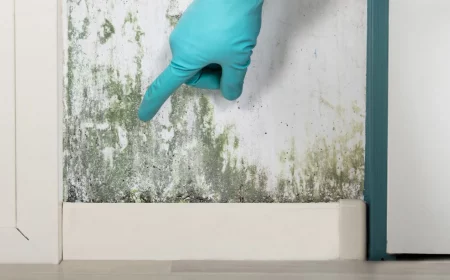Your Basement Laundry Room Doesn’t Have to Suck: A Pro’s Guide to Getting it Right
I’ve been in the home construction business for a long time, and if there’s one space that gets consistently ignored, it’s the basement laundry area. You know the scene: a lone washer and dryer shoved against a cold, damp concrete wall, with cobwebby pipes and a single flickering bulb for company. Most people write it off as a lost cause. But honestly? I see it as a huge missed opportunity. A properly set-up laundry room is more than just a place for chores—it’s a safe, efficient workspace that brings real value and sanity to your home.
In this article
This isn’t about creating a space worthy of a magazine cover (unless you want to!). It’s about applying solid, practical building principles to what can be a tricky part of the house. We’re going to get into the nitty-gritty stuff that actually matters: keeping moisture out, getting ventilation right, ensuring the electrical setup is safe, and designing a layout that doesn’t make you dread laundry day. These are the lessons I’ve learned from years on the job, fixing other people’s mistakes and teaching new folks the right way to do things. My goal is to pass that real-world knowledge on to you.
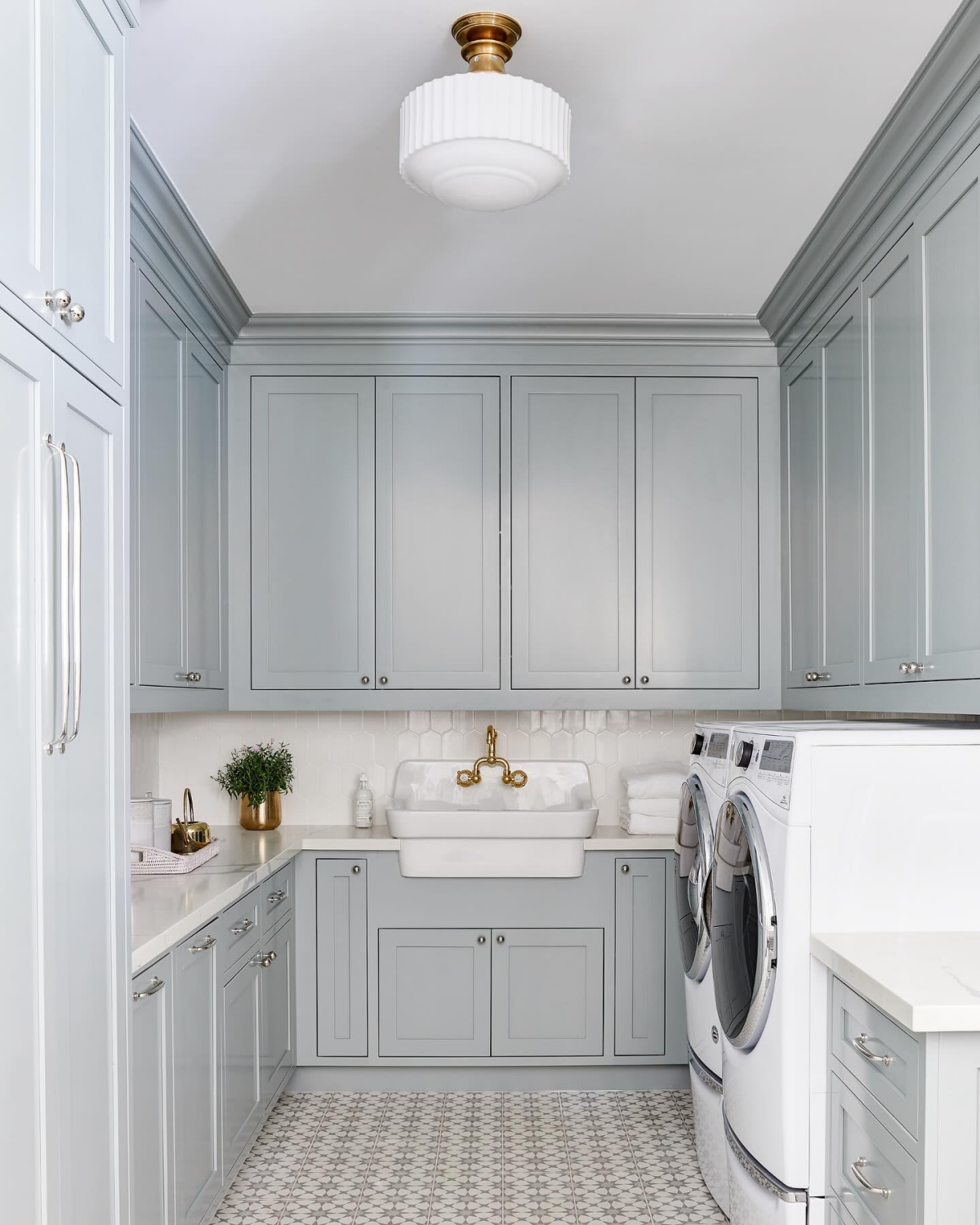
First Things First: Give Your Basement a Reality Check
Before you even think about new flooring or fancy cabinets, you have to get real about the space you’re dealing with. A basement is its own unique beast, and skipping this assessment is hands-down the biggest mistake people make. Let’s figure out what you’re working with.
Moisture is Public Enemy #1
Let me be clear: if you have a moisture problem, no amount of pretty paint will fix it. You have to tackle it head-on. Start by playing detective. See any white, chalky stuff on the concrete walls or floor? That’s called efflorescence, and it’s a dead giveaway that water is moving through the concrete. What about a constant musty smell? Yep, that’s mold or mildew, and they absolutely love damp basements.
For a more scientific approach, grab a digital hygrometer. You can get a good one for about $15-$25 online or at any big-box store. Just stick it in the laundry area and check it for a few days. Ideally, your home’s humidity should be between 30% and 50%. If you’re consistently hitting over 60%, you’ve got a problem that a good dehumidifier can likely solve. Also, give the foundation walls a thorough inspection for cracks, especially after a heavy rain. Small cracks can often be sealed with epoxy injections, but anything major needs a foundation specialist. Seriously, don’t just cover up a water issue. Solve it.
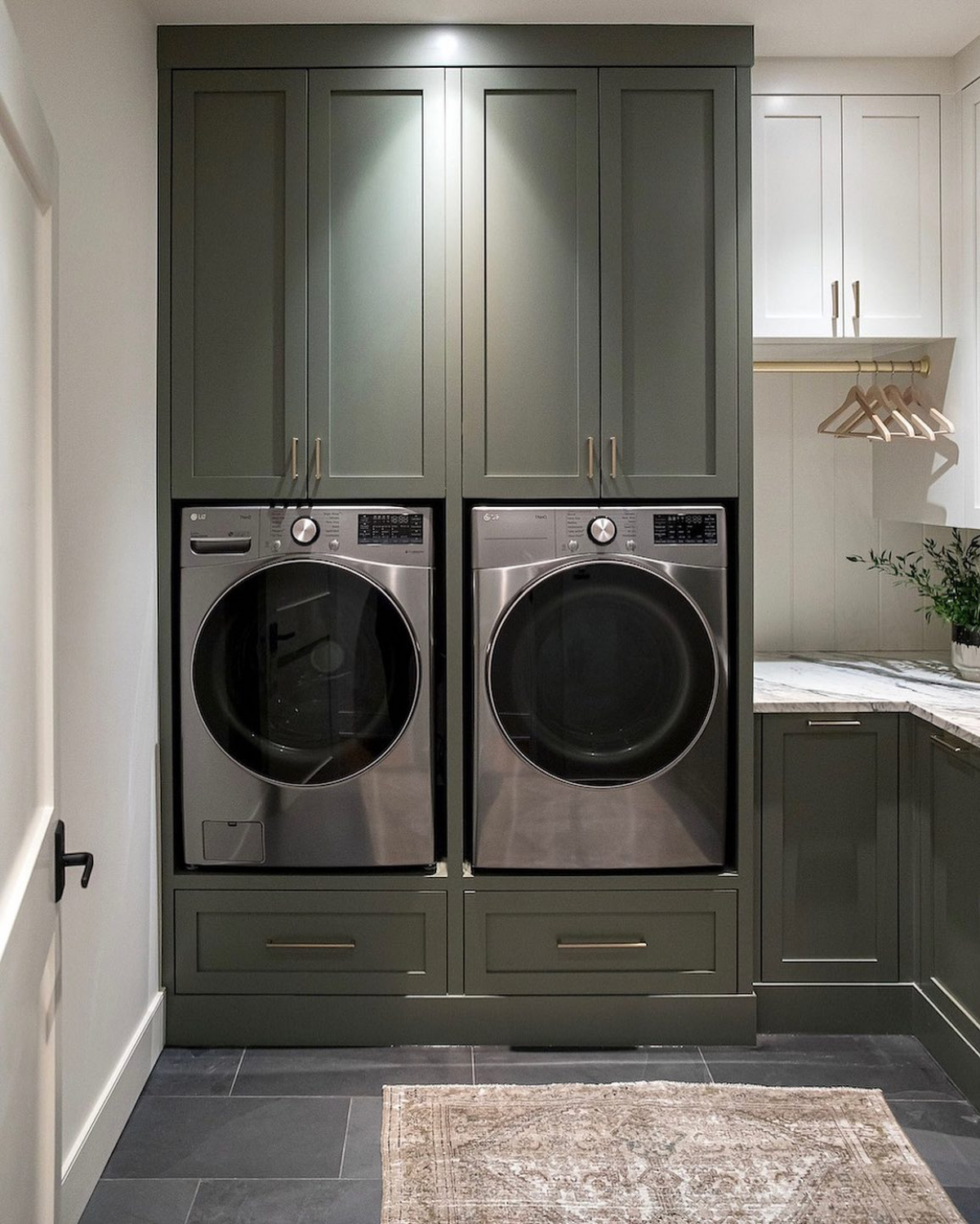
Let’s Talk Codes and Permits
I know, I know… paperwork. But any project that involves new plumbing, electrical wiring, or dryer venting is going to require a permit. This isn’t just red tape; it’s a critical safety measure. I’ve seen the aftermath of unpermitted work, from electrical fires to catastrophic water damage. Building codes are there to stop that from happening.
A licensed electrician will make sure your outlets are GFCI-protected (a must-have for wet areas), and a licensed plumber will ensure your drains are properly installed to keep nasty sewer gas out of your home. Not sure where to even start? Just go to your town or county’s official website and search for “building permits.” You’ll usually find all the forms and contact info you need right there. It’s a simple first step that a lot of people get hung up on.
Check Your Existing Hookups
Take a good, hard look at your current setup. For the washer, you need hot and cold water lines and a standpipe drain that’s between 30 and 36 inches high with a P-trap. For an electric dryer, you need a dedicated 240-volt, 30-amp circuit with that specific 4-prong outlet. If you have a gas dryer, you’ll need a standard 120-volt outlet plus a gas line with a shutoff valve, which should only be handled by a pro.
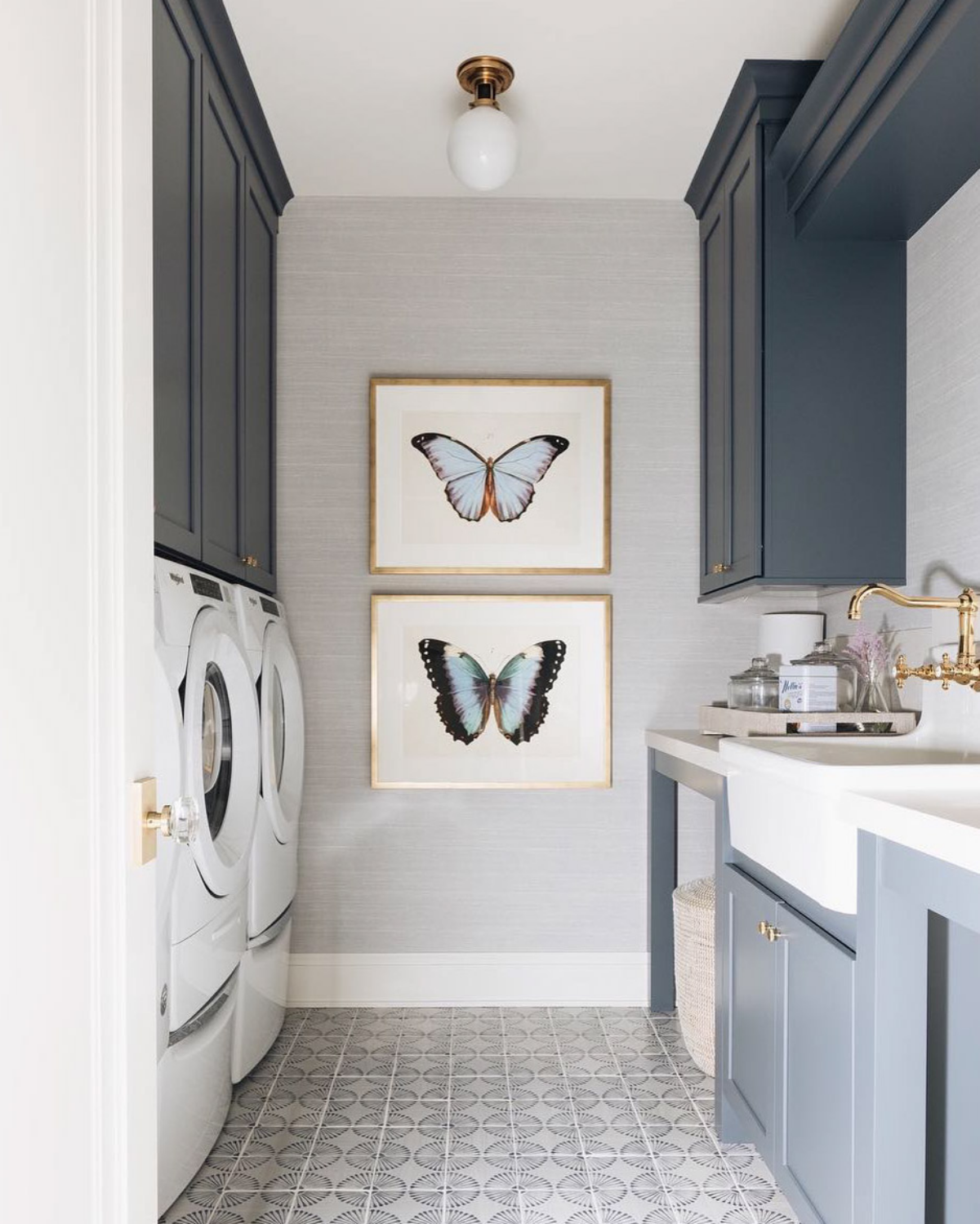
And the dryer vent… is it that flimsy, foil-like flexible tube? That stuff is a major fire hazard and needs to go. This quick survey will tell you if you’re looking at a simple appliance swap or a more involved renovation.
Creating a Healthy, Functional Space
A laundry room is basically a machine that processes clothes, but it also processes a ton of moisture and air. Getting the science right is the key to a room that won’t cause problems for the rest of your house.
Ventilation and Why It Matters So Much
Your clothes dryer is essentially a powerful exhaust fan, pushing around 200 cubic feet of air outside every single minute. All that air has to be replaced from somewhere. It’s a basic law of physics. In an airtight home, this can create what’s called negative pressure, turning your house into a giant vacuum. This is legitimately dangerous because it can pull carbon monoxide from your furnace or water heater right back into your living space.
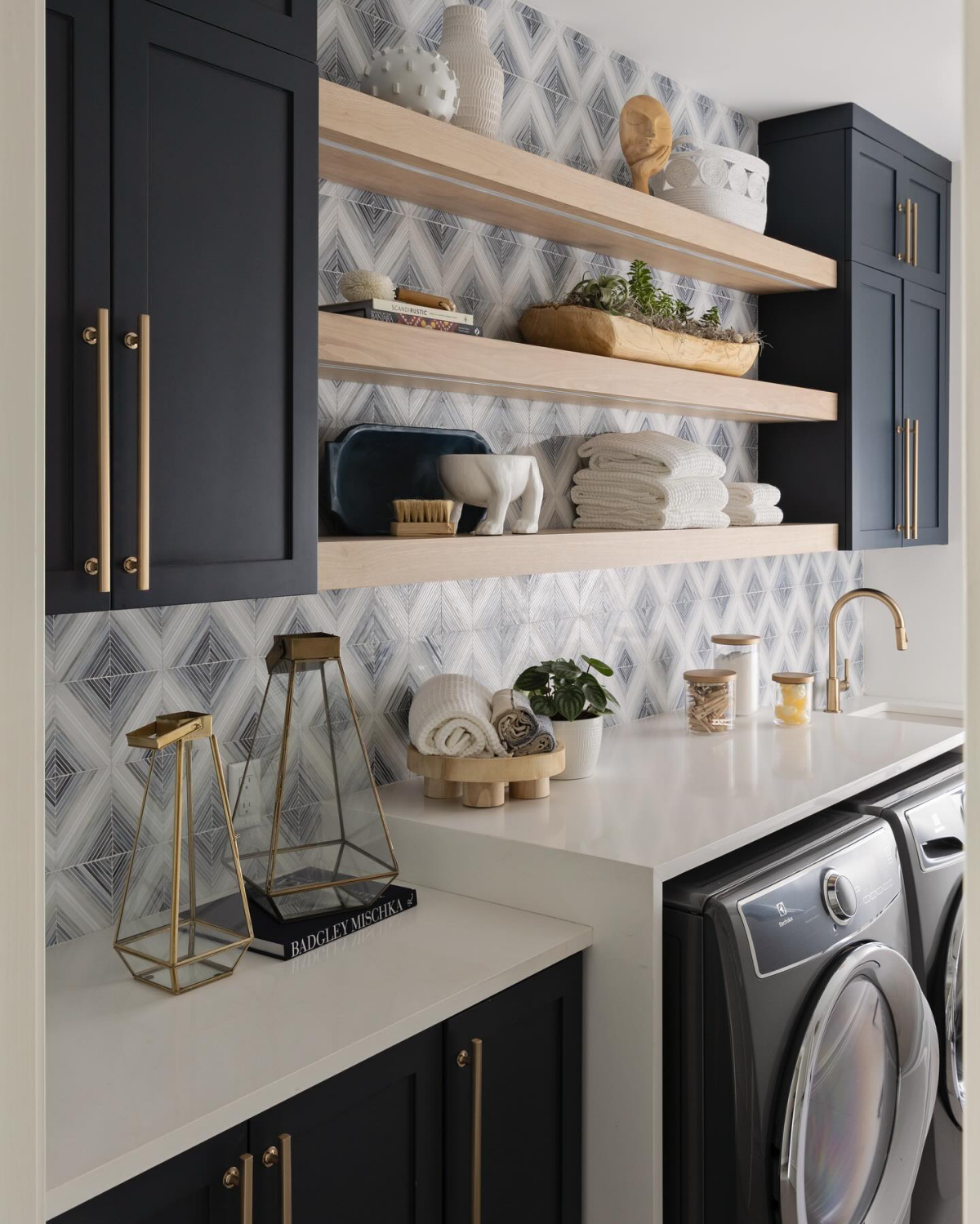
The fix can be as simple as installing a louvered door on the laundry room to allow air to flow in. In addition to the dryer vent, I always recommend a dedicated exhaust fan, just like the one in your bathroom. Pro tip: Wire it to a humidistat. This little sensor will automatically kick the fan on when the humidity gets too high and turn it off when things are back to normal. It’s a set-it-and-forget-it solution to get all that steamy wash-cycle air out before it causes trouble.
Flooring That Can Handle a Basement
Your flooring choice here is critical—it absolutely must be 100% waterproof. Don’t even consider anything else.
My go-to recommendation is Luxury Vinyl Plank, or LVP. It’s tough as nails, looks fantastic, and couldn’t care less about water. For a typical 10×10 room, a reasonably skilled DIYer can knock out an LVP installation in a weekend. It generally runs between $3 to $7 per square foot and is designed to “float” over the concrete, but you absolutely must put a vapor barrier down first.
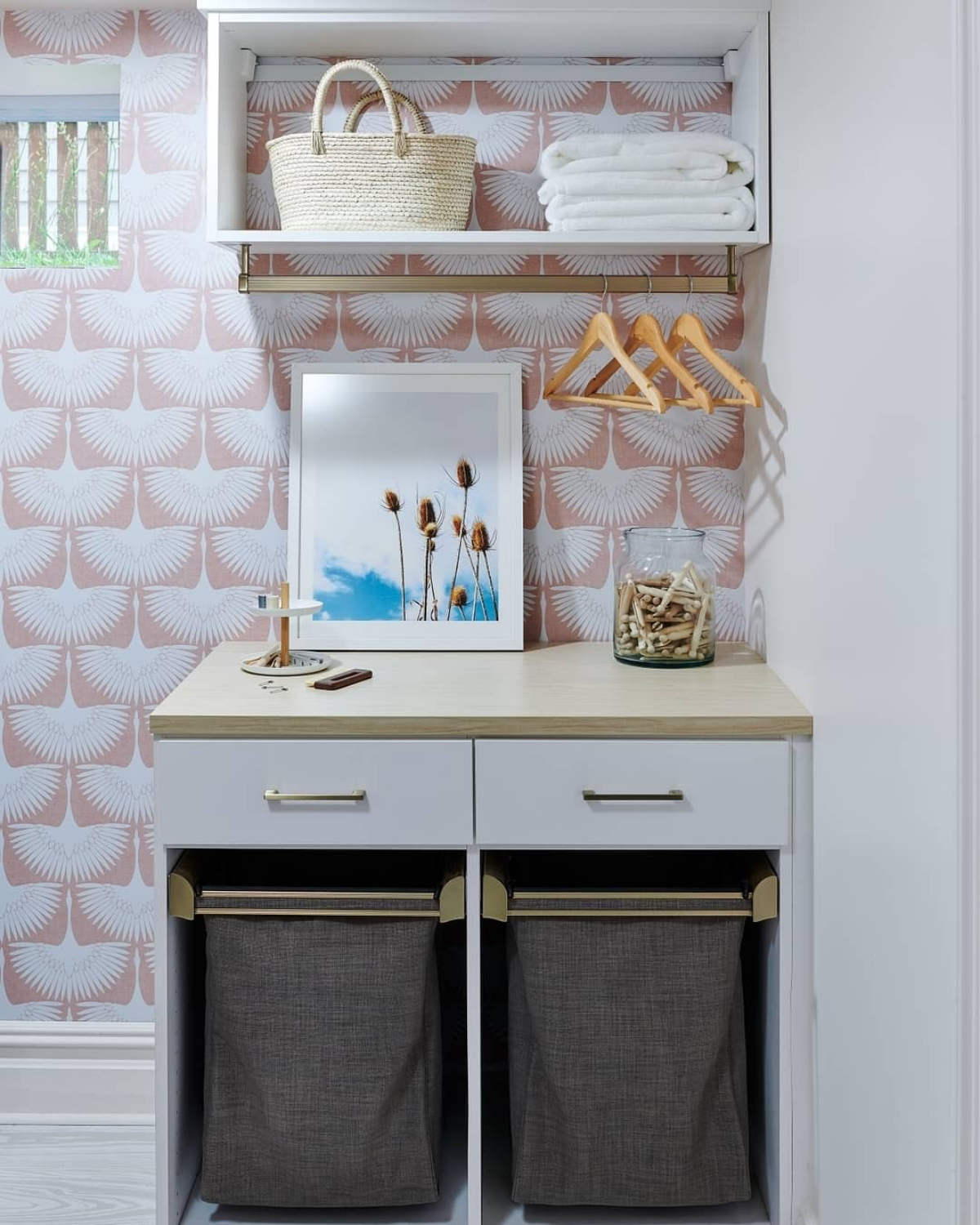
Porcelain or ceramic tile is your other bombproof option. It’s incredibly durable and completely waterproof. It’s a bit less DIY-friendly than LVP and costs a bit more, usually in the $5 to $15 per square foot range, installed. If you’re putting tile on a concrete slab, using an uncoupling membrane is non-negotiable. This is a special mat that goes between the concrete and the tile, absorbing tiny shifts in the slab so your tile and grout don’t crack. Pros swear by it for a reason.
Walls, Ceilings, and Hiding Ugly Pipes
For the walls and ceiling, make sure you use moisture-resistant drywall (often called “green board” or “purple board”). It’s specifically designed to resist moisture and mold. When it comes to the ceiling, you have a choice: a finished drywall ceiling looks clean and seamless, but a drop ceiling with removable panels gives you easy access to all the pipes and wires running above. And trust me, you’ll be thankful for that access if you ever have a leak.

Basements are notorious for having pipes and ducts running in awkward places. The pro way to handle this is to frame a soffit (a simple box frame) around them and cover it with drywall. It makes the obstruction look intentional. Or, if you like the industrial vibe, you can clean and paint all the exposed ductwork and joists a single matte black color to make them disappear.
The Little Things That Make a Big Difference
Once the bones are good, a few key fixtures can take your laundry room to the next level.
Don’t Skip the Utility Sink
Seriously, a deep utility sink is a game-changer. It’s perfect for pre-soaking stained clothes or cleaning up random messes. You’ve got options from classic cast iron to modern stainless steel, or more budget-friendly acrylic sinks. Whatever you pick, just make sure it’s plumbed correctly.
Let There Be (Good) Light
Bad lighting makes everything worse. For a laundry room, you need bright, clean light to spot stains and tell your navy blue socks from your black ones. I recommend a layered approach: use recessed LED lights for overall brightness and then add an LED strip light under your upper cabinets to light up your folding counter. A quick tip: look for bulbs with a high Color Rendering Index (CRI) of 90 or more—it means colors will look true and not washed out.
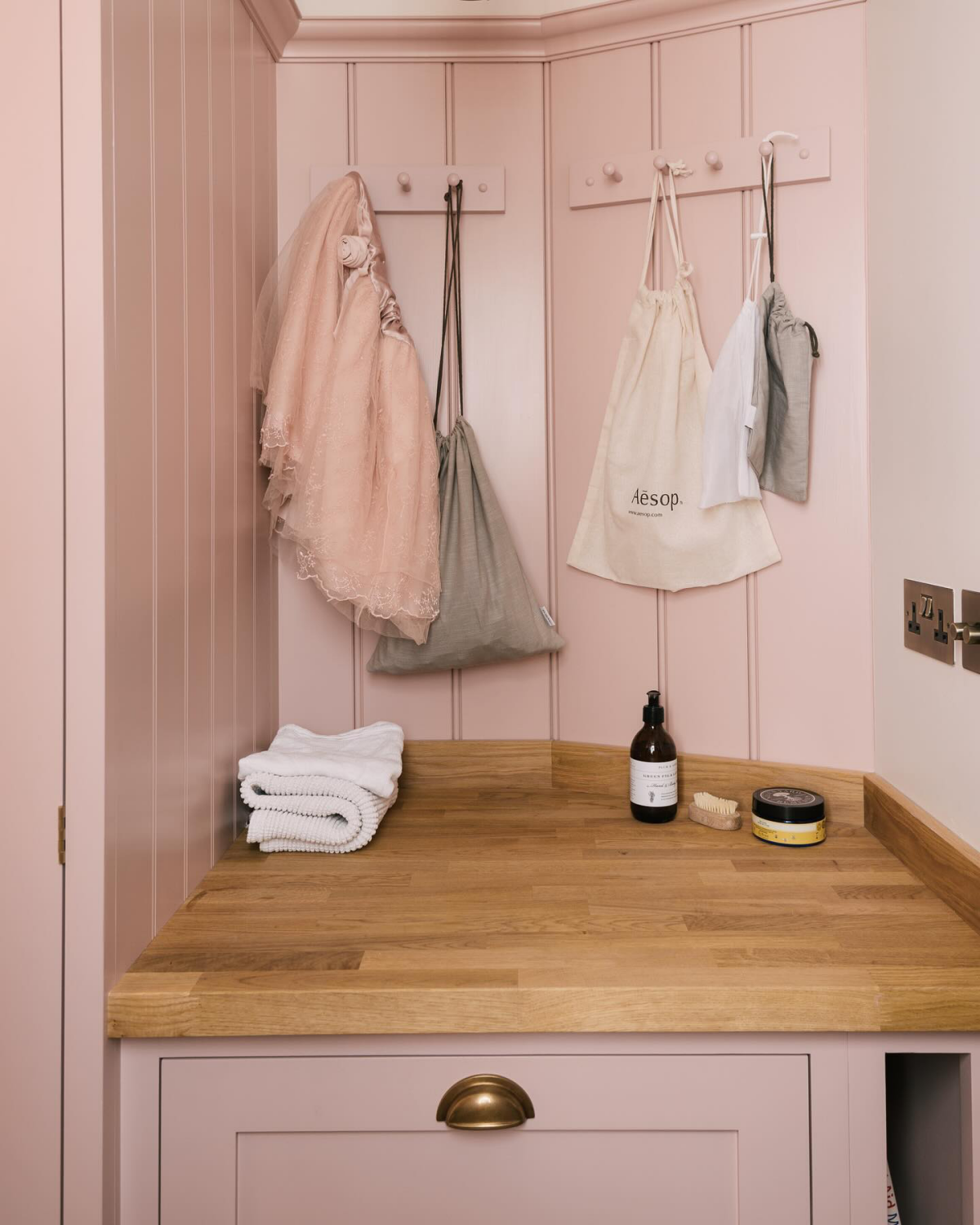
Smarter Storage Solutions
Good storage is about more than just hiding stuff. I find a mix of closed cabinets and open shelves works best. Standard upper kitchen cabinets are great because they offer enclosed storage without sticking out too far. Oh, and here’s a trick I learned from a cabinet installer: if you have the space, design in a tall pantry cabinet. It is the PERFECT spot to hide your ironing board, broom, and other awkward tall items.
Quick Fixes and Weekend Upgrades
Don’t have the budget for a full renovation? No problem. You can make your current space significantly safer and more functional this weekend for under $100.
Here’s your shopping list for a Weekend Safety Upgrade:
- Braided Steel Washer Hoses: Old rubber hoses are a flood waiting to happen. A new set of burst-resistant braided steel hoses costs about $25 and takes five minutes to install. I once saw an entire basement destroyed by a cheap rubber hose that failed. This is the best money you’ll ever spend.
- Rigid Metal Dryer Vent: That flexible foil duct is a fire hazard clogged with lint. A proper rigid metal vent kit is about $30 at Home Depot and dramatically improves airflow and safety.
- GFCI Outlet: If your washer outlet isn’t GFCI-protected, swap it out. A new GFCI outlet is about $20. If you’re not 100% confident with electrical work, this is a quick and inexpensive job for an electrician.
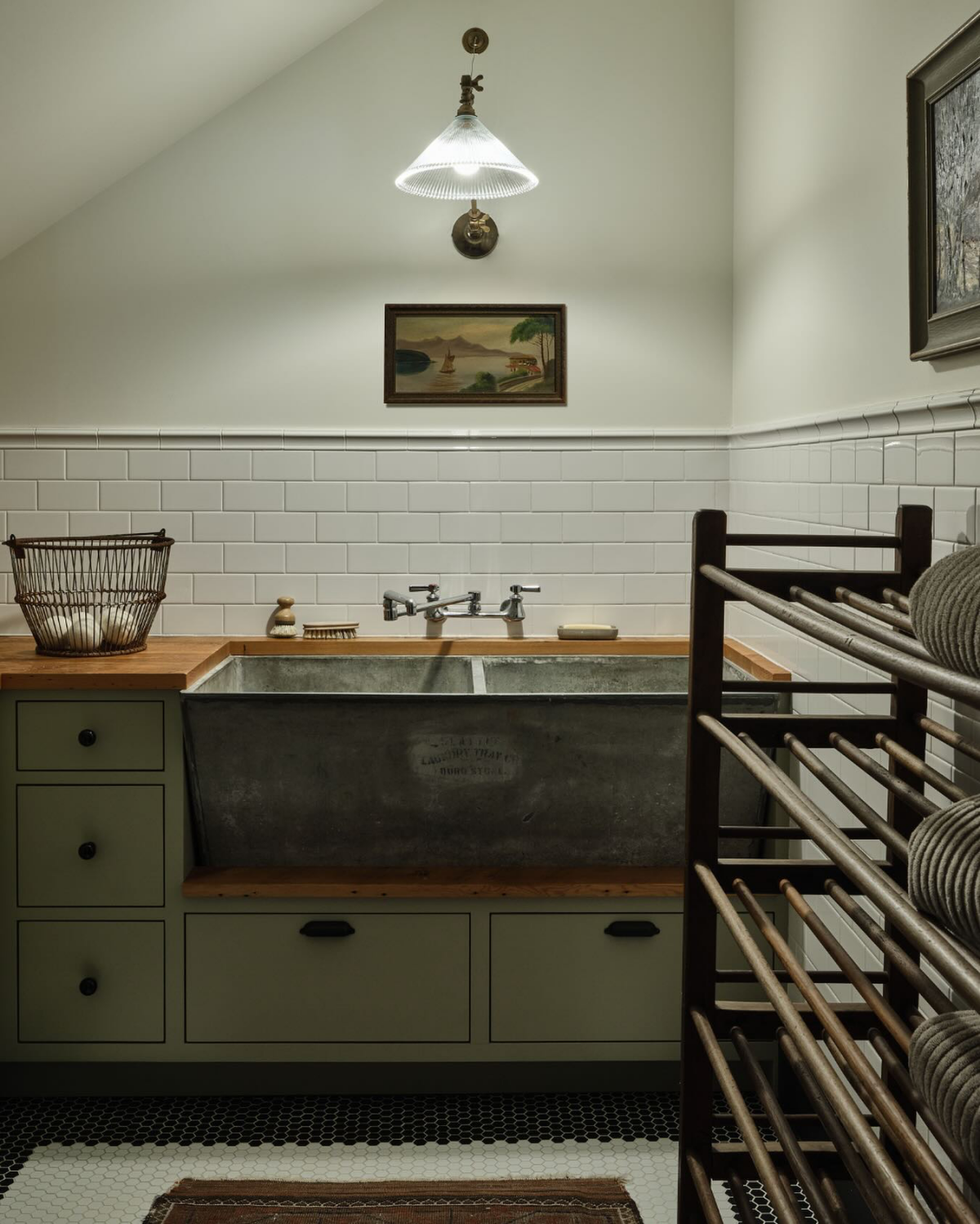
How to Clean Your Dryer Vent in 20 Minutes
If your dryer is taking forever to dry clothes, a clogged vent is almost always the culprit. Cleaning it is easy. Heads up! Do this once a year.
- Unplug the dryer from the wall. Safety first!
- Carefully pull the dryer out and disconnect the vent duct from the back.
- Grab a dryer vent cleaning kit—they’re about $20 online and come with a brush that attaches to your drill. Snake it all the way through the vent line to the outside. You will be shocked by how much lint comes out.
- Go outside and make sure the exterior vent flap is clean and opens easily.
- Reconnect everything, and you’re done. Your dryer will work better and be much safer.
Knowing When to DIY vs. Call a Pro
So, what can you do yourself? Things like painting, installing LVP flooring, and assembling stock cabinets are totally within reach for a handy homeowner. But some jobs are best left to the licensed professionals. This includes any new electrical circuits, all plumbing work (especially drains), and anything involving a natural gas line.
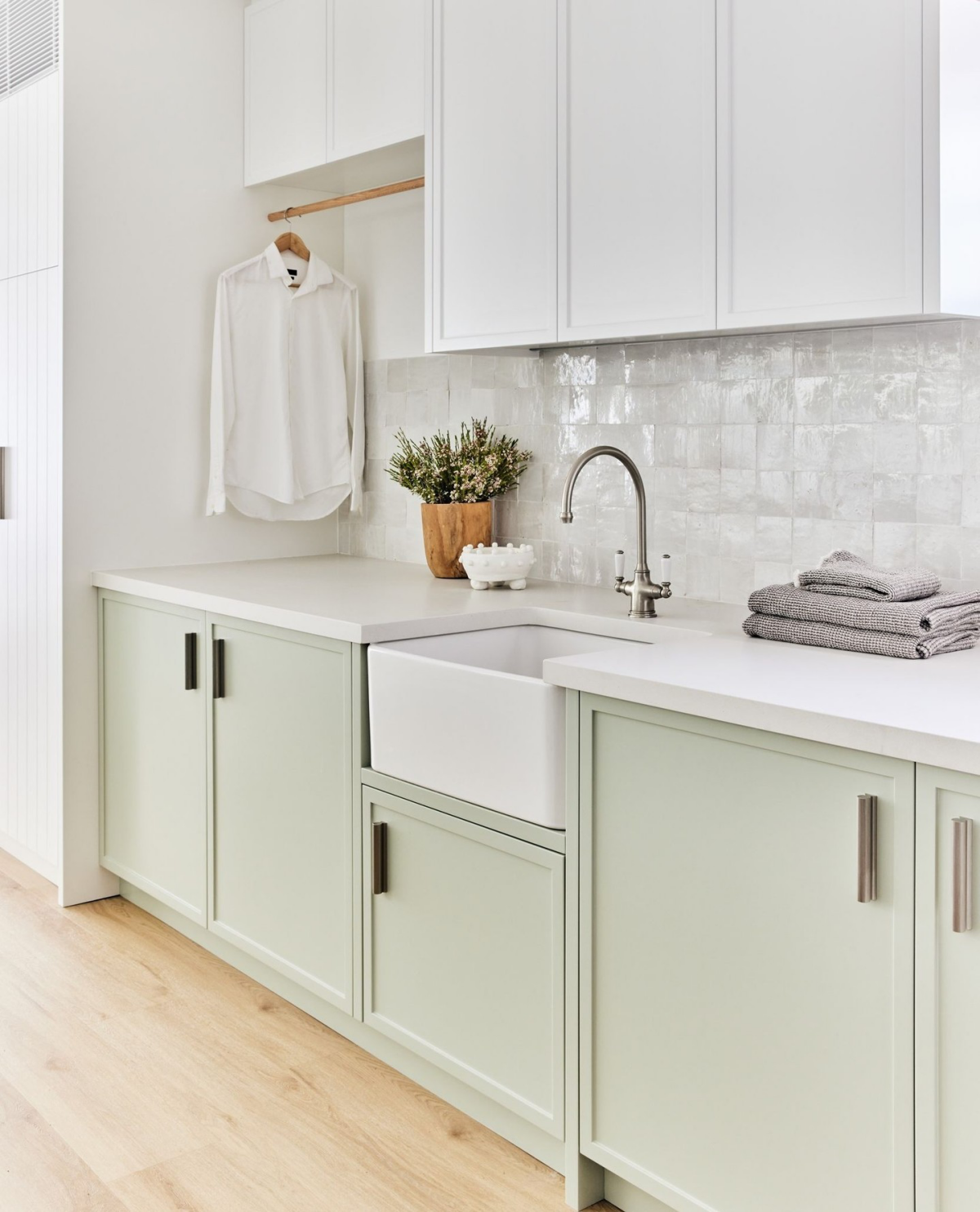
A simple cosmetic refresh might run you $2,000 to $5,000 if you do the labor. But a full-gut renovation involving pros for plumbing and electrical can easily be $15,000 to $25,000 or more. By the way, those washer and dryer pedestals that lift the machines up? They run about $250-$300 a pop. I had a client skip them to save money, and six months later they told me they regretted it every single time they did laundry. Your back will thank you.
Be honest about your skills and your budget. It’s always better to do a smaller project the right way than to cut corners on a big one. Getting these fundamentals right will give you a laundry room that’s not just functional, but a genuinely pleasant and safe part of your home.
Galerie d’inspiration
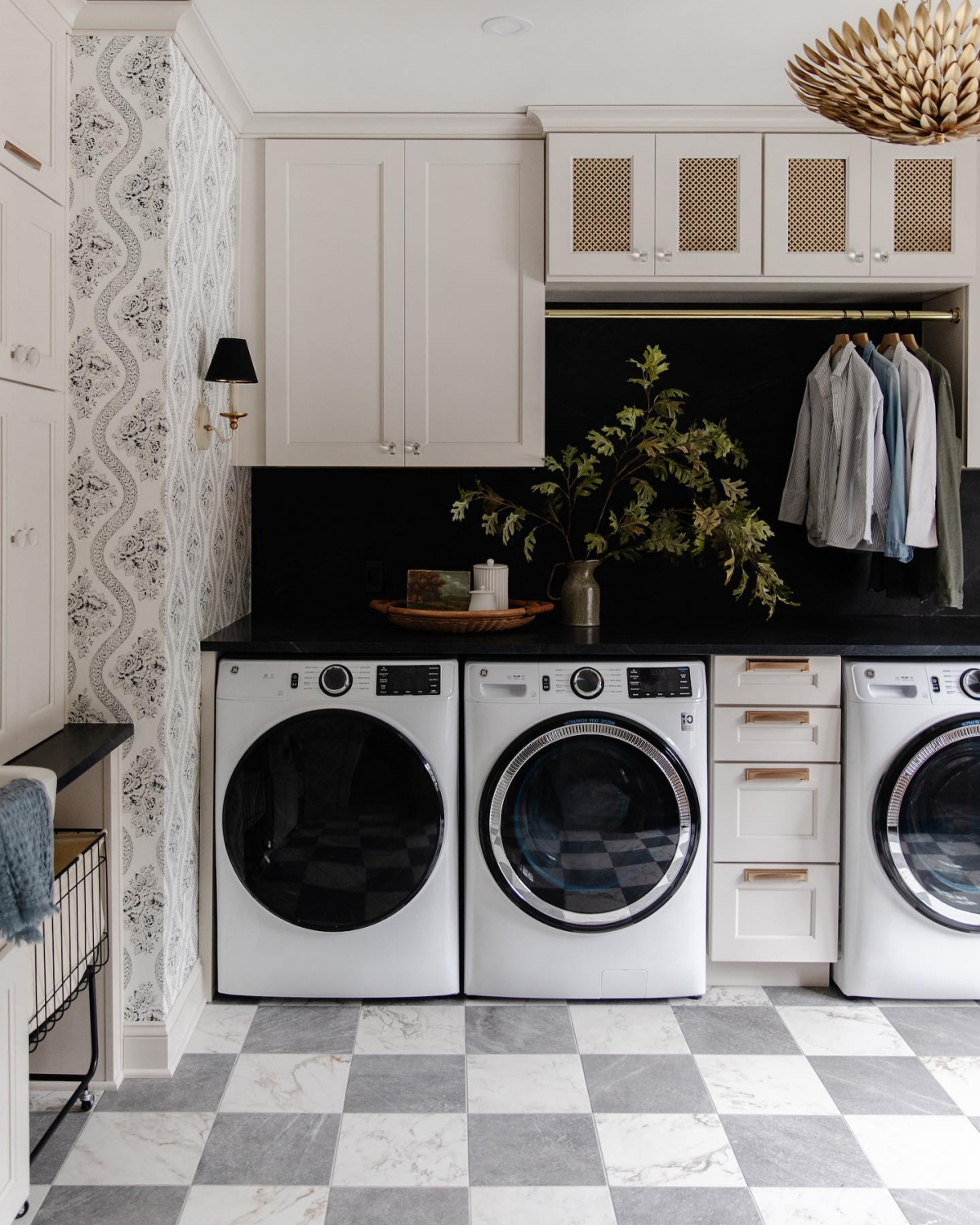
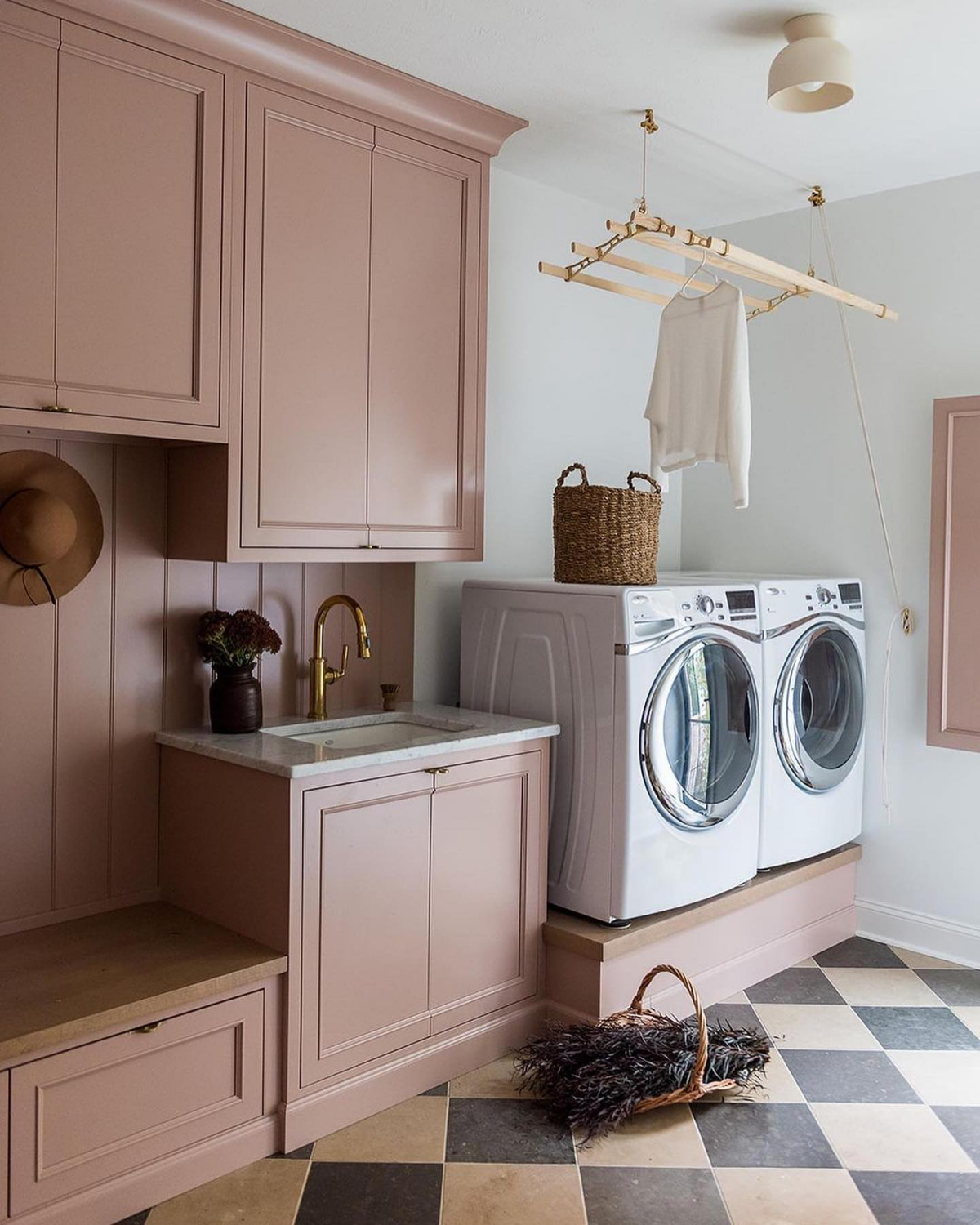
Flooring Face-Off: Luxury Vinyl Tile (LVT) vs. Epoxy Coating.
LVT: Offers a warmer, softer feel underfoot and comes in countless wood or stone looks. It’s highly water-resistant, but standing water can eventually seep through seams if not installed perfectly.
Epoxy: Creates a seamless, non-porous surface that is completely waterproof and incredibly easy to clean. Modern epoxies from brands like Rust-Oleum offer colors and flake finishes that go far beyond battleship gray.
For basements with any moisture history, epoxy provides the ultimate peace of mind. For a dry, finished basement, LVT offers more design versatility.
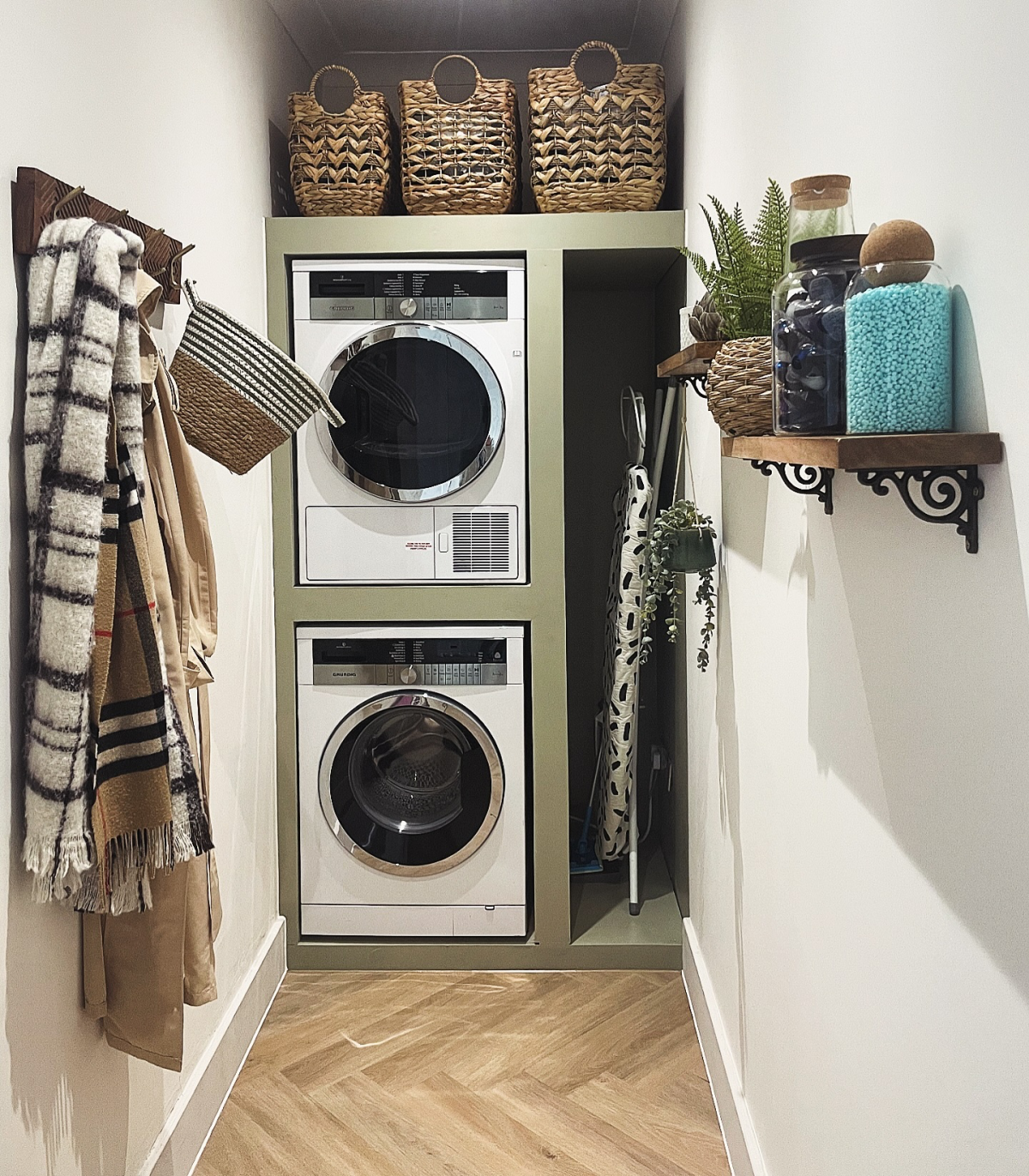
Don’t let your laundry room lighting be an afterthought. A single overhead fixture creates harsh shadows, making tasks like stain treatment difficult. Think in layers for a space that is both functional and inviting:
- Ambient: Start with a bright, flush-mount LED ceiling light for overall illumination.
- Task: Install an under-cabinet light strip above your folding counter or sink area. This targeted light is a game-changer.
- Accent (Optional): A small, stylish wall sconce can add a touch of warmth and design flair, making the space feel less utilitarian.
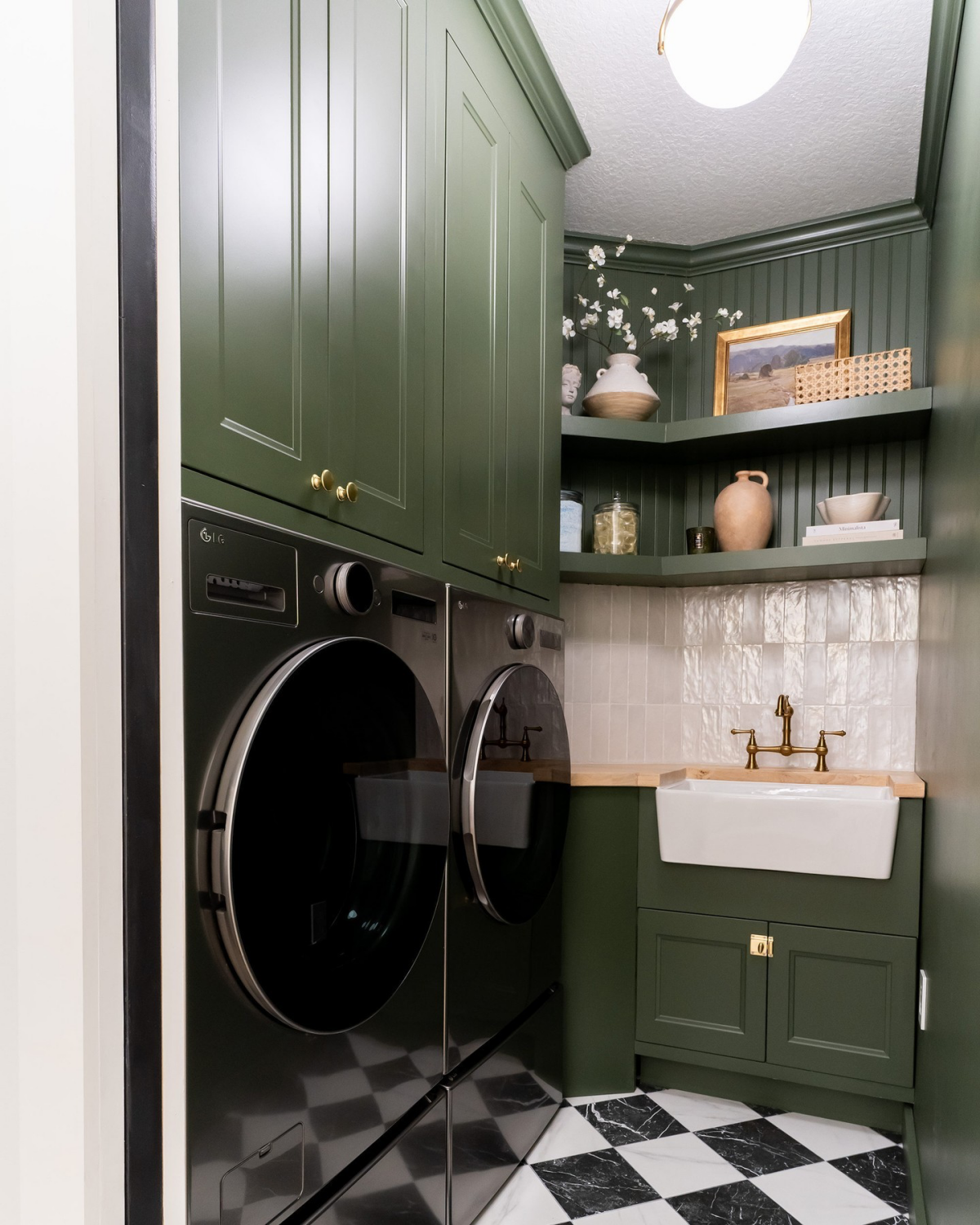
According to the U.S. Environmental Protection Agency, a full-size ENERGY STAR certified clothes washer uses about 25% less energy and 33% less water than a conventional machine.
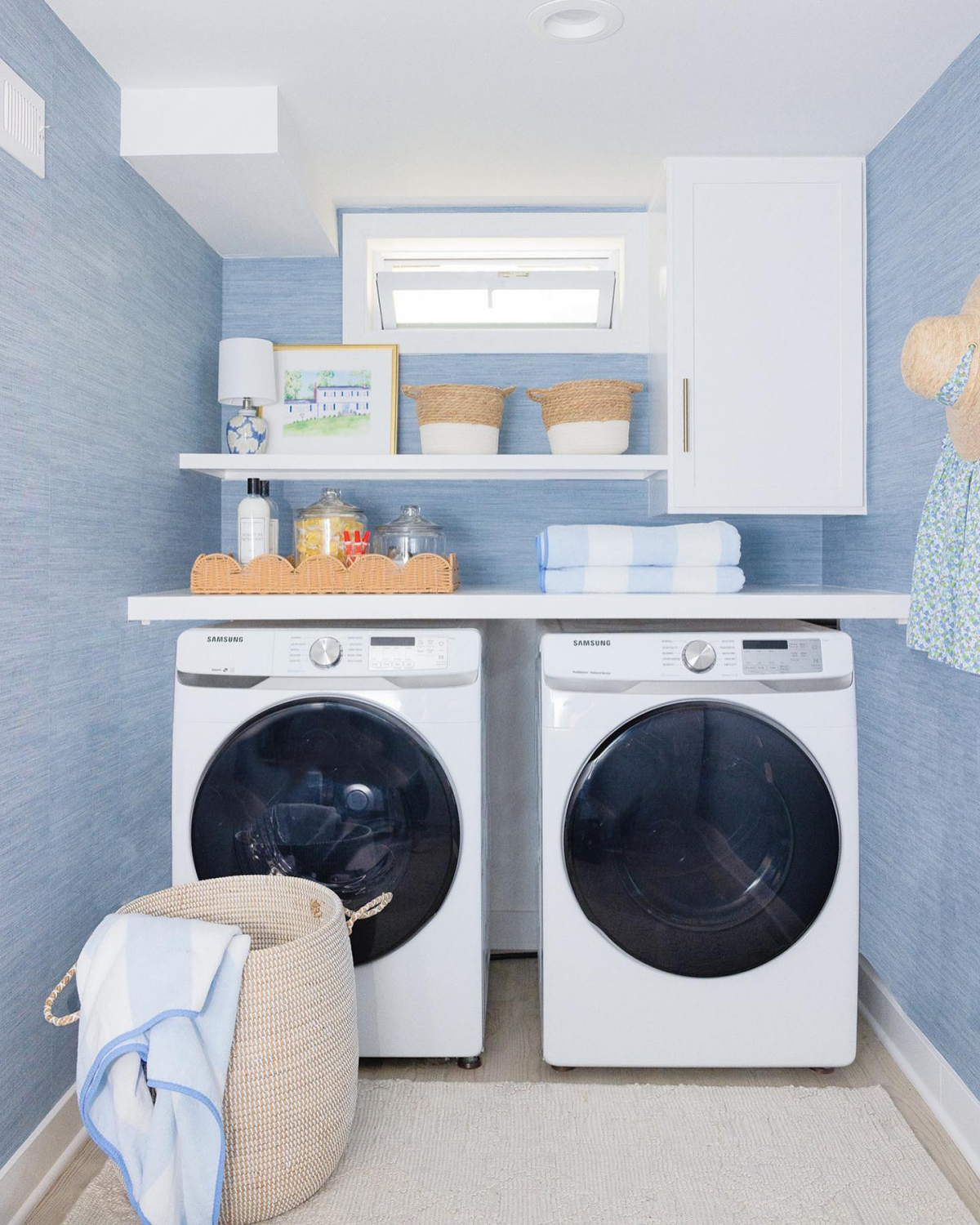
Wondering how to gain floor space in a cramped basement corner?
Look up. A stackable washer and dryer is the single most effective way to reclaim square footage. Models like the LG WashTower or Electrolux’s front-load pair with a stacking kit consolidate the laundry footprint into a neat vertical column. This frees up valuable space for a folding counter, a utility sink, or much-needed storage, transforming a tight spot into a highly efficient work zone.
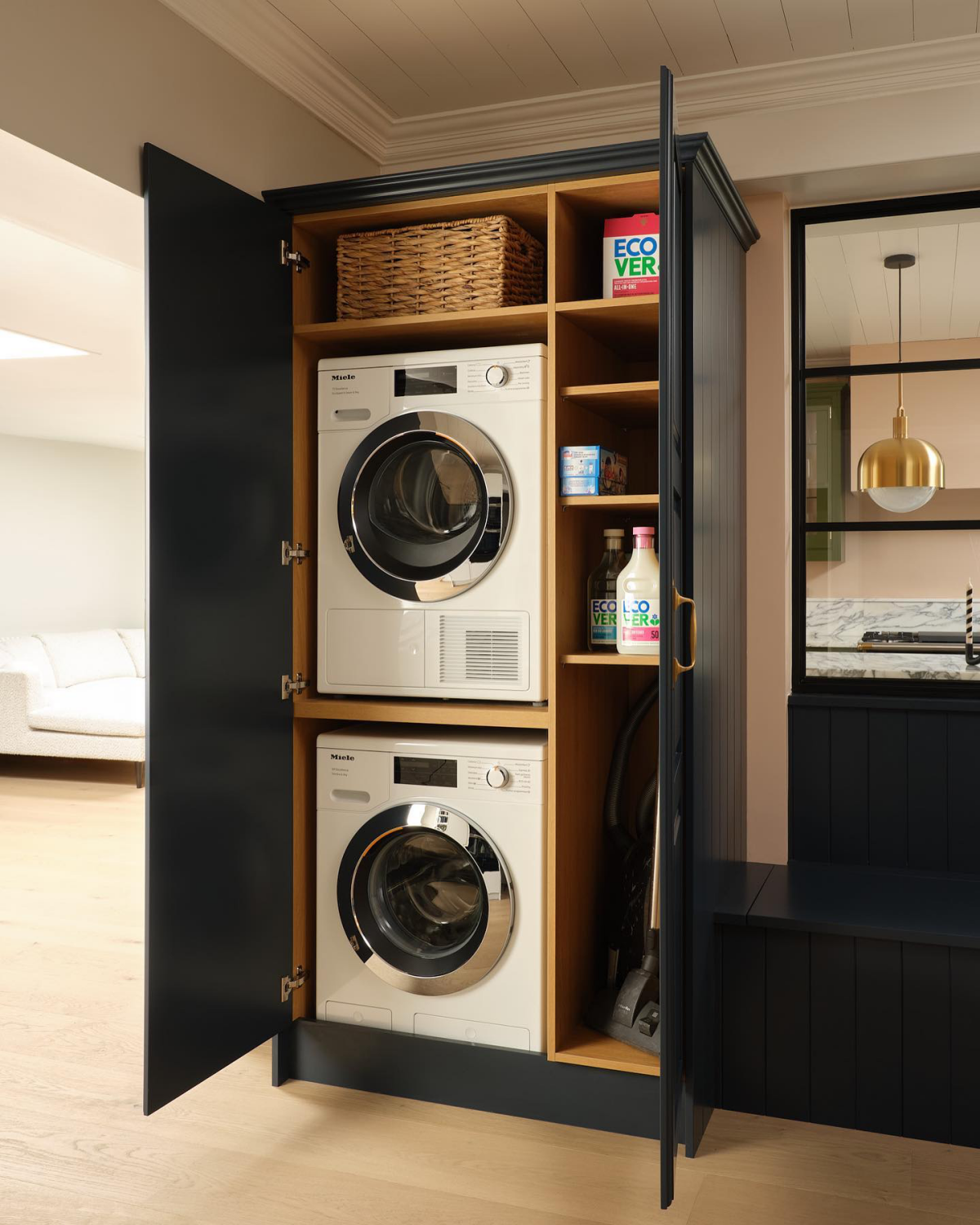
- Lessens the disruptive rumble and vibration that travels through the floor joists.
- Creates a quieter, more pleasant atmosphere in the rooms directly above.
The secret? Anti-vibration pads. Placing these thick rubber or sorbothane pads under the feet of your washer and dryer is a simple, inexpensive fix that absorbs a surprising amount of operational noise. It’s a must-do step for any laundry area located beneath a bedroom or living space.
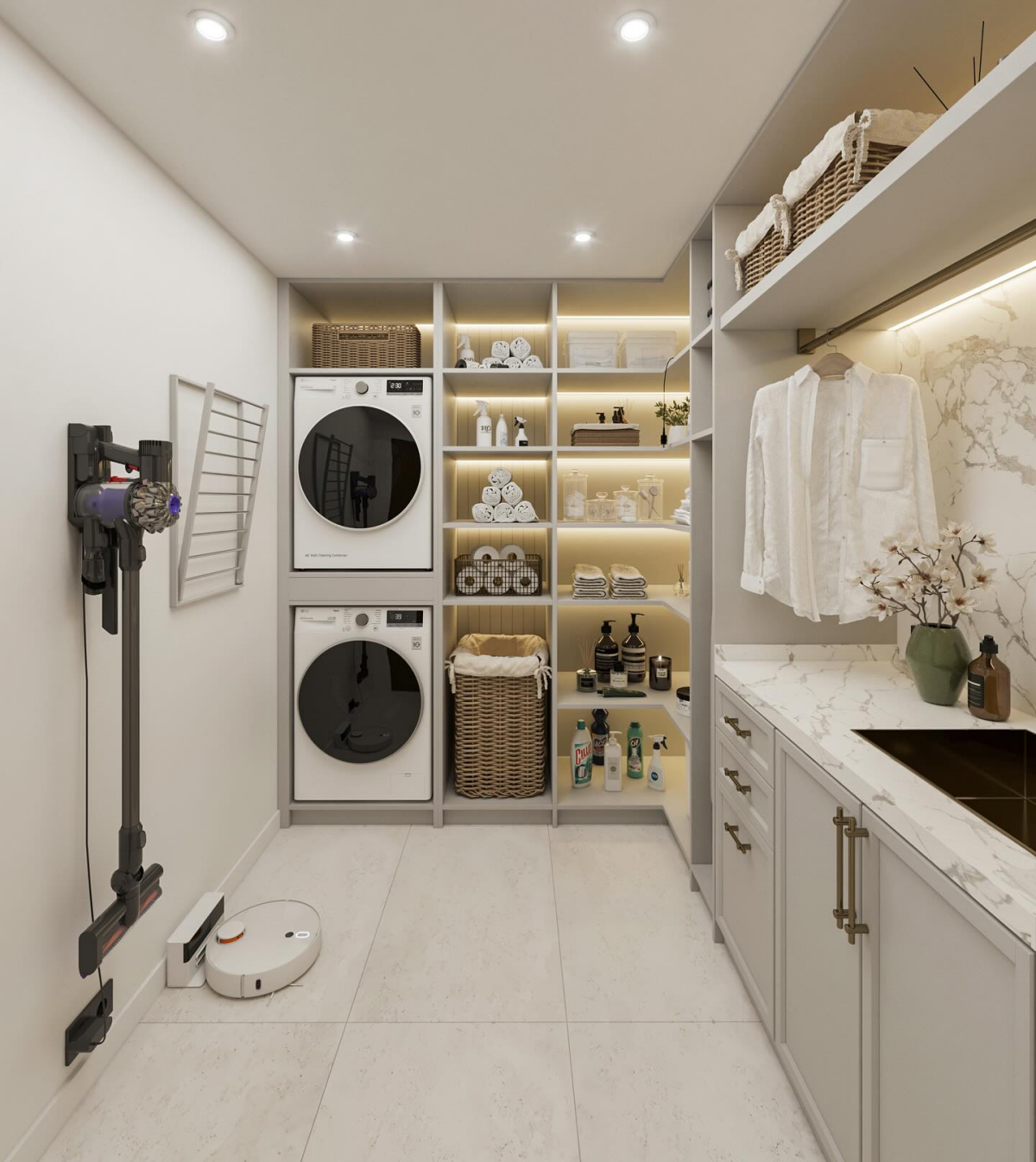
When painting concrete walls, the right product is more important than the color. Look for a dedicated masonry paint that is specifically formulated to be mildew-resistant and handle the unique alkalinity of concrete. Products like Zinsser’s Perma-White or BEHR’s Masonry, Stucco & Brick Paint create a durable, breathable barrier that helps manage the minor moisture vapor inherent in most basements.
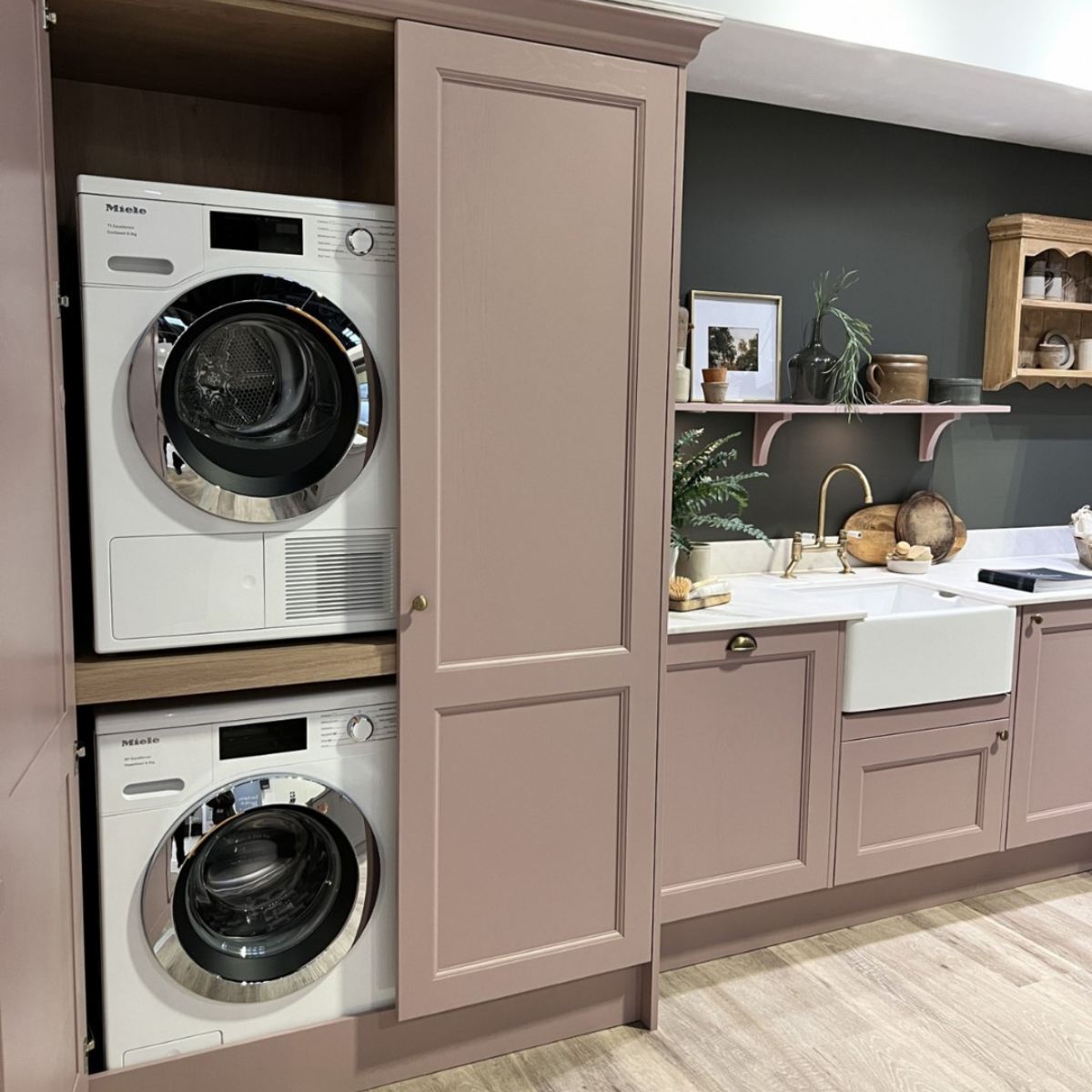
A common ventilation mistake: Terminating the dryer vent directly into the basement or a crawl space. This dumps massive amounts of moisture and lint into the air, creating a perfect environment for mold and becoming a serious fire hazard. Your dryer vent must always be routed to the exterior of your home through a dedicated, properly sealed vent cap.
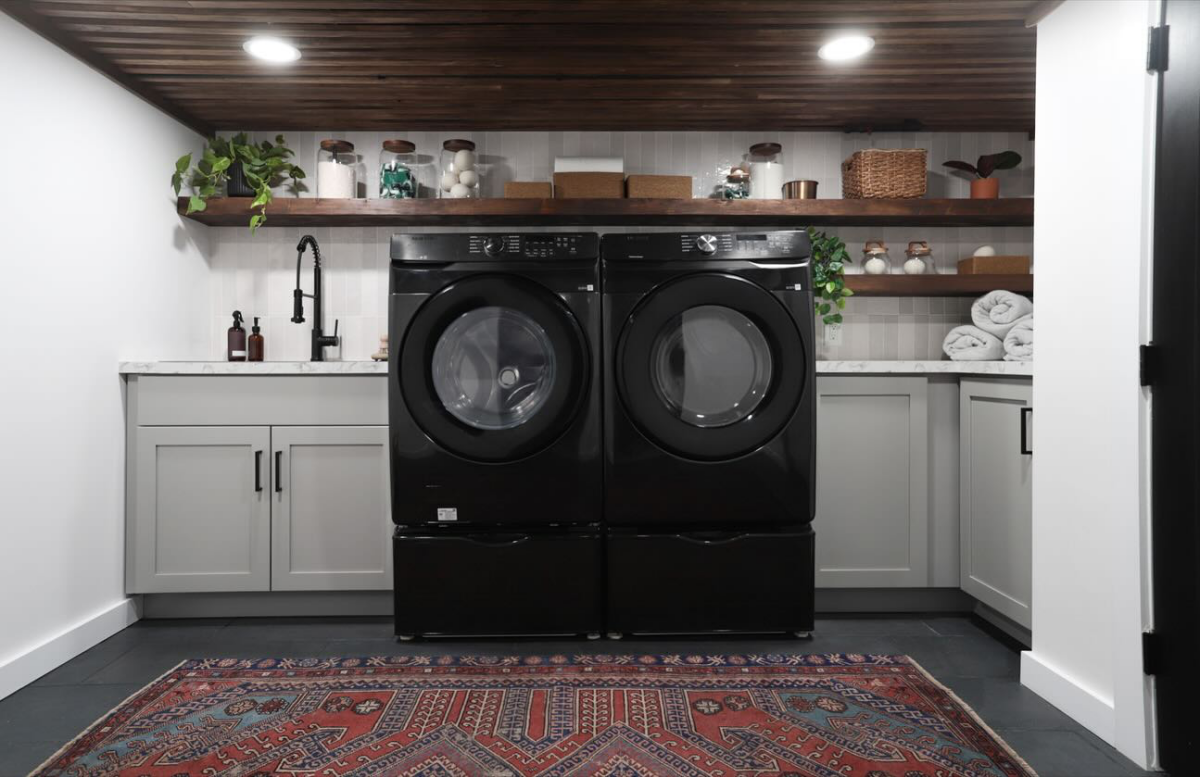
A 2021 study by the National Association of Home Builders found that a dedicated laundry room was rated as ‘essential’ or ‘desirable’ by 87% of home buyers.
This statistic underscores that investing in your laundry space isn’t just about your own convenience. A functional, well-lit, and dry laundry area is a significant value-add for your property, contributing directly to its overall appeal and resale potential. It’s a project that pays you back in both daily sanity and future equity.
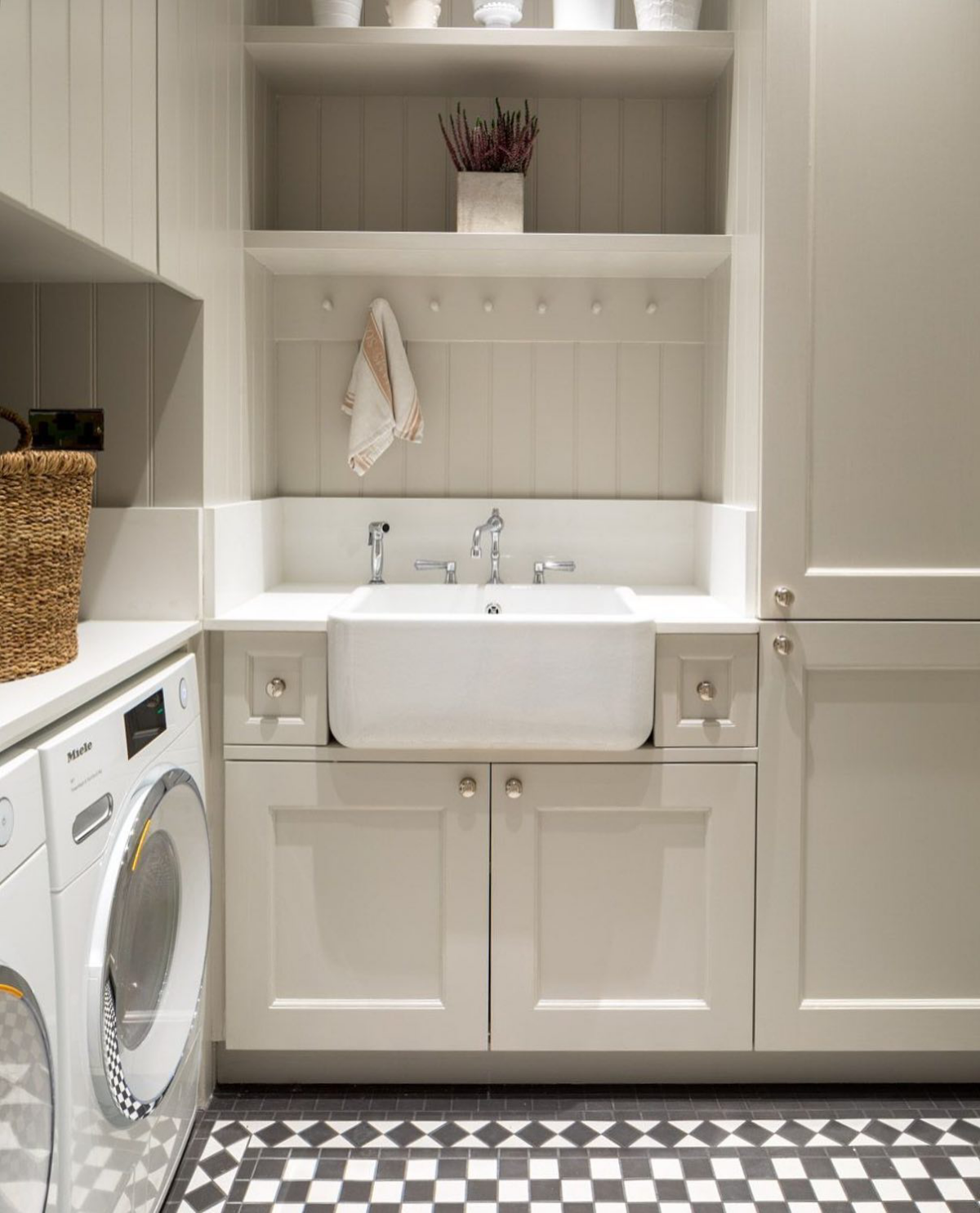
Custom cabinetry is beautiful but costly. For smart, budget-friendly storage, think modular. An IKEA BOAXEL wall-mounted system offers customizable shelves, drying racks, and baskets that can be configured to fit your exact space. Alternatively, simple pre-made upper kitchen cabinets from a home improvement store provide ample closed storage for detergents and supplies at a fraction of the custom price.
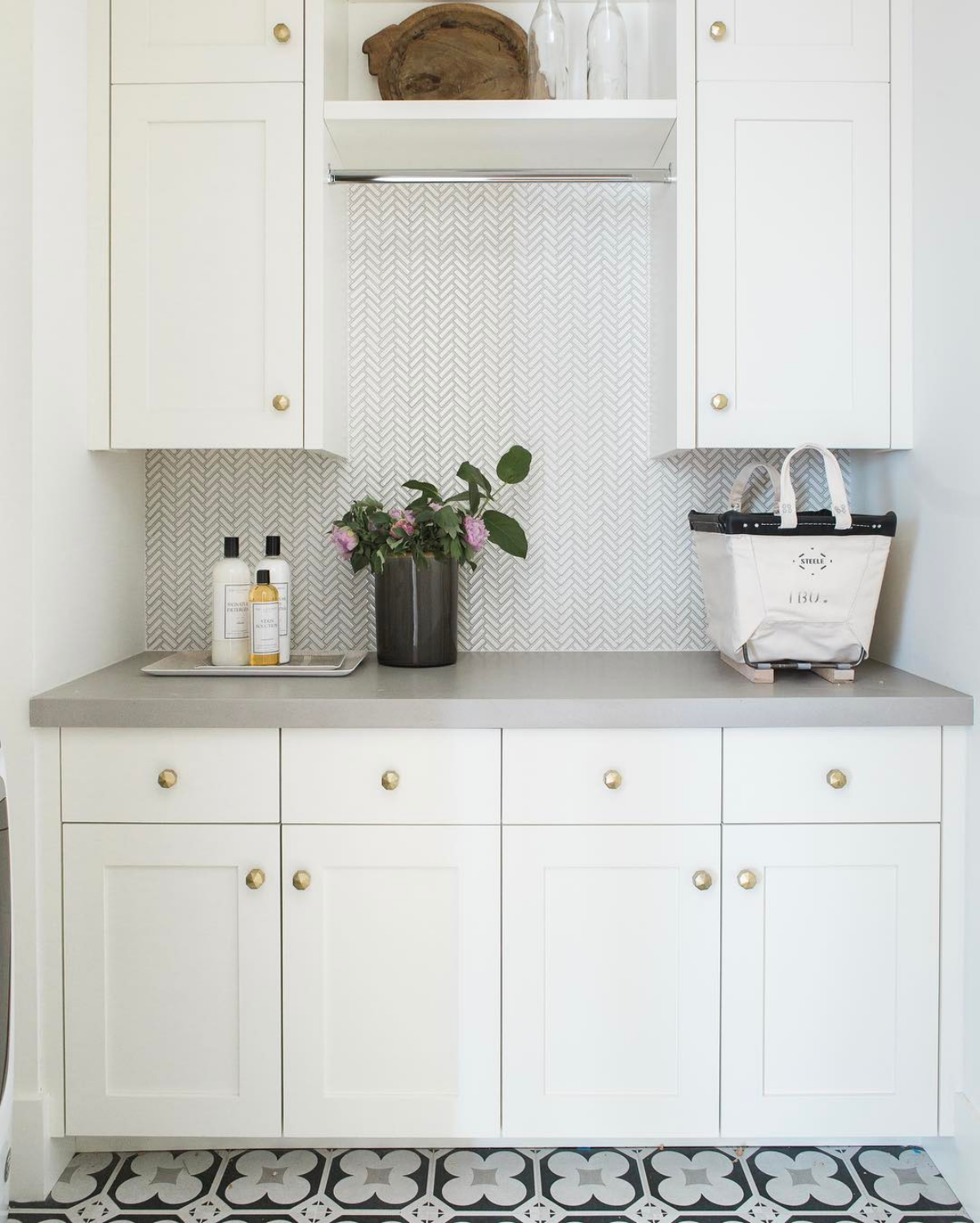
- Install a Wall-Mounted Folding Counter: Use sturdy brackets to affix a butcher block or laminated shelf to the wall. For tight spaces, choose hinged brackets so you can fold it down when not in use.
- Create a
The convenience of a basement laundry room is often offset by the hassle of running up and down stairs to check on cycles. This is where Wi-Fi-enabled appliances truly shine. Washers and dryers with smart features, like Samsung’s SmartThings or LG’s ThinQ apps, send a notification to your phone when a load is finished. This small tech upgrade eliminates guesswork and lets you manage your laundry efficiently from anywhere in the house.






